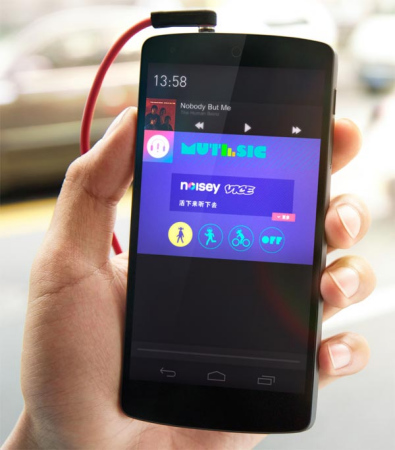
Mutesic, a mobile phone application introduced in China last year, was Saatchi & Saatchi's latest attempt to adopt the latest technologies to help improve people's lives. [Photo/China Daily)
Being flexible is key to success in an industry undergoing dramatic shifts, ad chief says
Advertising agencies must adapt to rapid changes and have a flexible approach if they want to succeed in the cut-throat world of marketing, said a leading industry official.
Robert Senior, global chief executive officer of Saatchi & Saatchi, said: "Emerging new technologies, dwindling client confidence and the ongoing economic downturn are major challenges for the industry, but there are still enough sweet spots for companies to tap into for growth."
Saatchi & Saatchi was one of the few companies that managed to stay profitable in what was a bleak year (2014) for most advertising companies. Much of that success, said Senior, stems from the company's China operations, which have maintained steady year-on-year growth.
Senior, who was appointed global CEO in January, reiterated that flexibility is the key to sustained growth. "We did not have any concrete plan to tackle the rapid changes that were occurring in our industry. But we believed that since we are part of the services sector, we must serve our clients with the best of our capabilities, even if they (clients) are changing tack," he said.
Marketing communication company ZenithOptimedia expects global advertising expenditure to grow by 4.9 percent to $545 billion this year. The estimate is down by 0.4 percentage point from the previous forecast in September 2014, with small downward revisions across many regions of the world. This means there is a minor but widespread decline in advertisers' confidence globally.
However, the picture in China is completely different. According to ZenithOptimedia, China overtook Japan to become the second-largest contributor of new advertisement revenue in the global market last year, behind the United States, and accounted for 19 percent of the total.
The rapid growth in the Chinese advertising market is more a result of industry practitioners adopting the new technologies and Western practices, benefiting from the rapid inflow of funds from investors hoping to tap into the country's growth opportunities, said Senior.
Since China has the largest number of Internet users in the world, Saatchi & Saatchi initiated a "hybrid experiment" project to collaborate with, build and learn from digital and technology startups. By bringing in people with expertise outside of the conventional agency role, the project allows employees to gain access to technology, and non-traditional thinkers provide a new way to create better work, he said.
What is more, the agency's digitalization strategy in China varies from other peers. While other agencies establish their own digital teams or departments, Saatchi & Saatchi empowers each team with the digital knowhow and capacity. This means, said Senior, that the creative staff will be able to deploy traditional and digital tools, according to the clients' requirements.
Digitalization is beset with several challenging conditions because the entry costs are relatively low. But it also means that companies need to be more nimble to have more options, Senior said.
The company has come out with several initiatives that seek to nurture and embrace the entrepreneurial spirit that the digital world encourages. "We don't talk about digital because it is as fundamental to us as the oxygen we breathe. It's not a discipline, it's just part of our agency. It also helps in the evolution of our talent base. When the going gets tough, the team automatically develops resilience," he said.
Senior said Saatchi & Saatchi also focuses on using the latest technology such as big data or cloud computing to leverage its offerings. Even though these technologies do not define the agency, they help in providing valuable insights and distribution.
Mutesic, a mobile phone app introduced in China last year, was Saatchi & Saatchi's latest attempt to adopt the latest technologies to help improve people's lives.
Together with the technology company Vice, the application automatically synchronizes with the user's current location using global positioning satellites, and then turns down the volume of the music to which the user is listening when they approach busy road intersections. This is also based on the fact that traffic accidents have increased by 300 percent in China because people wearing headphones drown out ambient warning sounds.
"It's undoubtedly technology-based. But the idea is human-based. Our starting point is not a mainframe, because we are not Accenture. We are an advertising agency. The start point is creativity. Then we see what platforms will help. We start with humans and we end with humans, and in the middle we have technologies," he said.
















































